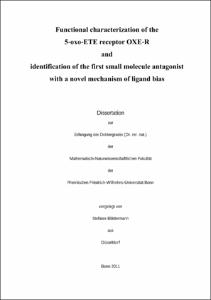Blättermann, Stefanie: Functional characterization of the 5-oxo-ETE receptor OXE-R and identification of the first small molecule antagonist with a novel mechanism of ligand bias. - Bonn, 2011. - Dissertation, Rheinische Friedrich-Wilhelms-Universität Bonn.
Online-Ausgabe in bonndoc: https://nbn-resolving.org/urn:nbn:de:hbz:5n-26773
Online-Ausgabe in bonndoc: https://nbn-resolving.org/urn:nbn:de:hbz:5n-26773
@phdthesis{handle:20.500.11811/5050,
urn: https://nbn-resolving.org/urn:nbn:de:hbz:5n-26773,
author = {{Stefanie Blättermann}},
title = {Functional characterization of the 5-oxo-ETE receptor OXE-R and identification of the first small molecule antagonist with a novel mechanism of ligand bias},
school = {Rheinische Friedrich-Wilhelms-Universität Bonn},
year = 2011,
month = oct,
note = {The lipid mediator 5-oxo-ETE (OXE) is a metabolite of the 5-lipoxygenase pathway and acts as a potent chemoattractant on eosinophils and neutrophils. OXE-induced effects are mediated via the Gi coupled 5-oxo-ETE receptor OXE-R, which is mainly expressed on immune cells like eosinophils, neutrophils, basophils and monocytes. The OXE-R is thought to play a pivotal role in inflammation and inflammatory diseases. For analysis of pathophysiologic effects of OXE-R signaling, an OXE-R antagonist would be needed, but to date, no small molecule OXE-R antagonist has been reported.
In the present thesis, a biomolecular screening in combination with a virtual screening was performed to discover OXE-R antagonists. In calcium mobilization assays, using a human recombinant cell line overexpressing the OXE-R and the promiscuous Gα subunit G16, three compounds were identified with inhibitory effects on the OXE-R G16 pathway: Gü 1157, Gü 1158 and Gü 1654. To explore the antagonistic efficacy of these compounds on the signaling pathways of the OXE-R, a number of functional assays were established to monitor receptor activation in recombinant cells, engineered to overexpress the OXE-R. In cAMP accumulation assays, Gü 1157, Gü 1158 and Gü 1654 were analyzed on the native Gi signaling pathway of the OXE-R. In this assay, the compounds did not show inhibitory activity on the Gi signaling pathway, suggesting that Gü 1157, Gü 1158 and Gü 1654 display biased antagonism at OXE-R G16 and Gi signaling. To confirm this hypothesis, DMR assays were established and Gü 1157, Gü 1158 and Gü 1654 were analyzed on the discrete OXE-R G16 and Gi pathways, respectively. The biased antagonism was confirmed for Gü 1654, but not for Gü 1157 and Gü 1158, which failed to inhibit OXE-R G16 DMR responses and were not pursued further.
It was evaluated if Gü 1654 maintains its biased antagonism on endogenously expressed OXE-R in human primary cells. Intriguingly, analysis of Gü 1654 on OXE-R Gi signaling in eosinophils and neutrophils by using two different assays monitoring Gi-mediated cellular effects uncovered Gü 1654 to inhibit OXE-R Gβγ-mediated calcium flux but not Gai signaling in cAMP assays.
In the present thesis, Gü 1654 was discovered as a novel small molecule OXE-R antagonist which is competent to selectively inhibit OXE-R signaling via different subunits of the same heterotrimeric Gi protein. This hitherto unprecedented mechanism of ligand bias provides new insight into GPCR signaling and will be relevant for the design of appropriate assays in drug discovery and development as well as for the design of therapeutics with targeted drug effects.},
url = {https://hdl.handle.net/20.500.11811/5050}
}
urn: https://nbn-resolving.org/urn:nbn:de:hbz:5n-26773,
author = {{Stefanie Blättermann}},
title = {Functional characterization of the 5-oxo-ETE receptor OXE-R and identification of the first small molecule antagonist with a novel mechanism of ligand bias},
school = {Rheinische Friedrich-Wilhelms-Universität Bonn},
year = 2011,
month = oct,
note = {The lipid mediator 5-oxo-ETE (OXE) is a metabolite of the 5-lipoxygenase pathway and acts as a potent chemoattractant on eosinophils and neutrophils. OXE-induced effects are mediated via the Gi coupled 5-oxo-ETE receptor OXE-R, which is mainly expressed on immune cells like eosinophils, neutrophils, basophils and monocytes. The OXE-R is thought to play a pivotal role in inflammation and inflammatory diseases. For analysis of pathophysiologic effects of OXE-R signaling, an OXE-R antagonist would be needed, but to date, no small molecule OXE-R antagonist has been reported.
In the present thesis, a biomolecular screening in combination with a virtual screening was performed to discover OXE-R antagonists. In calcium mobilization assays, using a human recombinant cell line overexpressing the OXE-R and the promiscuous Gα subunit G16, three compounds were identified with inhibitory effects on the OXE-R G16 pathway: Gü 1157, Gü 1158 and Gü 1654. To explore the antagonistic efficacy of these compounds on the signaling pathways of the OXE-R, a number of functional assays were established to monitor receptor activation in recombinant cells, engineered to overexpress the OXE-R. In cAMP accumulation assays, Gü 1157, Gü 1158 and Gü 1654 were analyzed on the native Gi signaling pathway of the OXE-R. In this assay, the compounds did not show inhibitory activity on the Gi signaling pathway, suggesting that Gü 1157, Gü 1158 and Gü 1654 display biased antagonism at OXE-R G16 and Gi signaling. To confirm this hypothesis, DMR assays were established and Gü 1157, Gü 1158 and Gü 1654 were analyzed on the discrete OXE-R G16 and Gi pathways, respectively. The biased antagonism was confirmed for Gü 1654, but not for Gü 1157 and Gü 1158, which failed to inhibit OXE-R G16 DMR responses and were not pursued further.
It was evaluated if Gü 1654 maintains its biased antagonism on endogenously expressed OXE-R in human primary cells. Intriguingly, analysis of Gü 1654 on OXE-R Gi signaling in eosinophils and neutrophils by using two different assays monitoring Gi-mediated cellular effects uncovered Gü 1654 to inhibit OXE-R Gβγ-mediated calcium flux but not Gai signaling in cAMP assays.
In the present thesis, Gü 1654 was discovered as a novel small molecule OXE-R antagonist which is competent to selectively inhibit OXE-R signaling via different subunits of the same heterotrimeric Gi protein. This hitherto unprecedented mechanism of ligand bias provides new insight into GPCR signaling and will be relevant for the design of appropriate assays in drug discovery and development as well as for the design of therapeutics with targeted drug effects.},
url = {https://hdl.handle.net/20.500.11811/5050}
}






